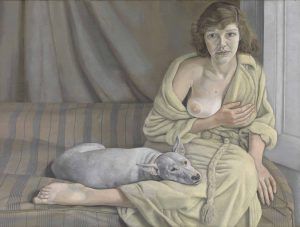Jenny Uglow at the NYRB:
 Nothing, however, prepares one for the tender ferocity of Bacon’s isolated, entrapped figures. In the earliest of these, the large canvas of Figure in a Landscape(1945), a curled-up, almost human form appears to be submerged in a desert—we see his arm and part of his body, but the legs of his suit hang, empty, over a bench. This is masculinity destroyed. The sense of desperation is even stronger in Bacon’s paintings of animals, such as Dog (1952), in which the dog whirls like a dervish, absorbed in chasing its tail, while cars speed by on a palm-bordered freeway, or Study of a Baboon (1953), where the monkey flies and howls against the mesh of a fence. In their struggles, these animals are the fellows of Bacon’s “screaming popes”: in Study after Velazquez (1950), a businessman in a dark suit, jaws wrenched open in a silent yell, is trapped behind red bars that fall like a curtain of blood. The curators connect Bacon’s postwar angst with Giacometti’s elongated statues, isolated in space, and to the philosophy of existentialism. Yet Bacon’s vehement brushstrokes speak of energy and involvement, physical, not cerebral responses. In Study for Portrait II (after the Life Mask of William Blake) (1955), you feel the urgent vision behind the lidded eyes. He cares, passionately.
Nothing, however, prepares one for the tender ferocity of Bacon’s isolated, entrapped figures. In the earliest of these, the large canvas of Figure in a Landscape(1945), a curled-up, almost human form appears to be submerged in a desert—we see his arm and part of his body, but the legs of his suit hang, empty, over a bench. This is masculinity destroyed. The sense of desperation is even stronger in Bacon’s paintings of animals, such as Dog (1952), in which the dog whirls like a dervish, absorbed in chasing its tail, while cars speed by on a palm-bordered freeway, or Study of a Baboon (1953), where the monkey flies and howls against the mesh of a fence. In their struggles, these animals are the fellows of Bacon’s “screaming popes”: in Study after Velazquez (1950), a businessman in a dark suit, jaws wrenched open in a silent yell, is trapped behind red bars that fall like a curtain of blood. The curators connect Bacon’s postwar angst with Giacometti’s elongated statues, isolated in space, and to the philosophy of existentialism. Yet Bacon’s vehement brushstrokes speak of energy and involvement, physical, not cerebral responses. In Study for Portrait II (after the Life Mask of William Blake) (1955), you feel the urgent vision behind the lidded eyes. He cares, passionately.
more here.
